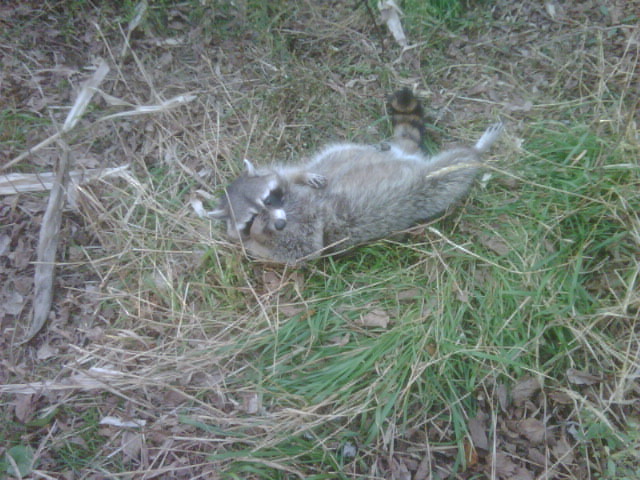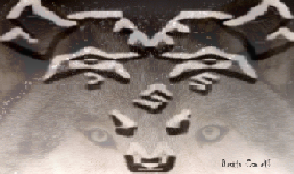Snaring Raccoon
Raccoon snaring is one of the easiest forms of trapping. Its also one of the cheapest methods. These two factors makes it a very beginner friendly methods. Once you learn a few basics, it does not take long to connect with a bunch of raccoons.

The Basics
They key to being a successful snareman/woman is understanding how big the animals are, how they move through different situations and what size loop and how high off the ground you need to make the snare based on those variables. With raccoons, those changes won't be drastic but they will be subtle enough to give you fits early on.
The basic loop size for snaring raccoon is a six inch diameter loop and six inches of the walking surface. This loop is my normal loop for most of the trails that I snare for raccoon. It lets the smaller coon go under the loop as well as the skunks and possums that happen to use the same trails. Also, it provides you the best chance at neck snaring a coon or at worst allowing just one leg through the snare which goes a long way towards preventing snare damage on the valuable back fur of the animal.
A quick note on neck snaring raccoons...If you plan on doing this, you must have a lock that will not loosen up when the animal stops pulling on the snare. Raccoons as most of you know have very good dexterity with their hands and can throw the snare off their head if it loosens up. If your not sure of your locks ability to stay put, test it at your shop first before trying to neck snare. If it fails to stay put, either get a different lock or plan on using a slightly lower loop to allow the raccoons to get a foot through the loop before it closes.
Depending on the terrain and vegetation, adjustments to the loop size and height of the ground will be needed. In places where the raccoons are going through thick grass or brush, I like to use my kill poles with a five inch loop and four to six inches off the ground depending on where the "hole" through the trail is. Raccoons are like most animals, they do not like things hitting their faces. I want the snare centered right where the animal will poke its nose through the middle of the loop. This height will vary based on the trail so you have to use your imagination and knowledge of the raccoon to figure out the sweet spot. Other situations like a trail going down a slope will require a lower snare height as they will be staying lower to the ground going up and down the trail.
Snare Selection
Selecting the kind of snare and setup is hardest part of snaring raccoon,unless your have to use restraints then you are basically limited to one or two different flavors of restraints. There are about as many snare systems as there are ways to catch them in footholds. There are three sizes of cable that are used for snaring raccoon: 1/16th, 5/64th and 3/32nd. The smaller cables are more lethal when used in entanglement but can really damage a pelt if the animal is flank/hip caught as they can dig deeper through the fur. Bigger cable is better for where you cannot try to neck snare a raccoon as it is harder for them to break the snare it cant dig into the fur as much.
These sizes are then offered in three different configurations in the wrapping: 1x19, 7x7, and 7x19. 7x19 is never used as a snare as it is too soft but it is great for snare extensions. 7x7 cable is soft as well and is susceptible to chewing but it is still a decent cable for raccoon and is used by a lot of people for 'coon snares. 1x19 cable is the favorite of alot of snaremen because it can be loaded to be an extremely fast closing snare, much harder for animals to chew through because the strands are so tightly woven together and can hold a more circular shape.
There are a few factors involved when selecting the snare lock you use for snaring raccoon. First is the law regarding snare locks where you intend to snare. Be sure on how your state defines a "relaxing lock" if your state requires them as that term is used loosely, as my state of Ohio defines it as any lock that does not tighten after the animal stops pulling and other states may define it as a lock that loosens up after the animal stops pulling. The second factor is whether you are trying to neck snare a coon for dispatch or try to body snare the raccoon. If you are neck snaring, you want a small lock that does not back up and closes fast. The small lock closes tighter on the animals neck to make dispatching the animal as quick as possible. For body snaring raccoon, a bigger lock helps minimize fur damage on body caught animals as it cannot tighten as hard on the animals. A lock that also backs up, a true relaxing lock, will also help reduce fur damage on body caught coon. Another factor is whether or not you have to use a deer stop and/or break away device on you snares. A deep stop requirement makes neck snaring for dispatch near impossible so body snaring is you main option here. If you can use a breakaway device, aka B.A.D. you can use many of those devices, either the s or j-hook type or release ferrules, or use snare locks that function as a B.A.D. like a Gregerson lock and the Grawe's 5/64 mini mag Bullet lock. Using a B.A.D. snare you can neck snare coons for dispatch.
My main build for raccoon snares is with 36 inches of 5/64th 1x19 cable with a slim lock, deer stop, and a swivel then an extension. Having the snare this short keeps the swivel close to the animal making it less likey to be fouled by any vegetation in the area. Using an extension instead of a long cable means I can reach whatever it is I am using to anchor the snare, either a tree, stake or kill pole, and saves on cable. For my kill poles, I use 36 inches of 1/16th 1x19 with a grawes 5/64th bullet lock and a swivel with an eight inch extension. All my snares are loaded.
All information on this site is © by Dustin Caudill. E-mail for permission to use information or picture at webmaster@sniperstrappingplace.com
